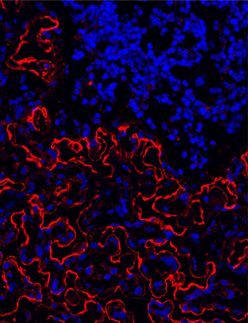Stem cells fill gaps in bones
Large defects will heal more quickly
Advertisement
For many patients the removal of several centimetres of bone from the lower leg following a serious injury or a tumour extraction is only the beginning of a long-lasting ordeal. Autologous stem cells have been found to accelerate and boost the healing process. Surgeons at the RUB clinic Bergmannsheil have achieved promising results: without stem cells, it takes on average 49 days for one centimetre of bone to regrow; with stem cells, that period has been reduced to 37 days.
Stretching the periosteum
In the past, large bone defect inevitably led to an amputation. Today, the arm or leg is stabilised in an external support, and a transport wire is pulled through the marrow of the intact part of the injured bone. Once the soft tissue surrounding the injury is healed, the surgeons cut the healthy part of the bone into two. The transport wire is affixed to the winches of a ring fixator that is attached around the leg. Using a sophisticated cable-pull system, the previously detached part of the bone is slowly pulled either downwards or upwards along the gap in the bone until it arrives and docks at the other end. During the pulling stage, the periosteum of the bone that had been pulled apart had been continuously stretched. Thus, a periosteum tube is created in the gap behind the relocated portion of the bone. Inside that tube, the new bone can regenerate. This process, however, is extremely tedious and the treatment fails in every firth case.
Processing autologous stem cells in the operating theatre
Surgeons at the RUB clinic Bergmannsheil attempt to optimise the healing process by applying autologous stem cells therapy. Depending on the requirements, stem cells are capable of evolving into different types of tissue cells, including so-called osteoblasts – cells that are responsible for bone formation. Adult stem cells such as are deployed in the process can be found in the bone marrow of adults. “We harvest them by inserting a hollow needle into the iliac crest,” explains PD Dr Dominik Seybold, managing consultant at the clinic. The stem cells are prepared for application directly on location. Under x-ray control, the surgeons inject six to eight millilitres of the concentrated fluid into the centre of the periosteum tube. X-ray controls are routinely performed to monitor the recovery progress. To date, the RUB physicians have applied this therapy in 20 cases. “This is not enough to be statistically relevant,” admits Dr Seybold. Nevertheless, the researchers find the results very encouraging: whilst the bone regeneration process without stem cells used to take 49 days on average, it has been reduced to 37 days on average thanks to the new therapy method. So far, RUB scientists have been treating bone defects with an average length of eight centimetres – consequently, the patients thus recovered, on average, three months sooner.



























































